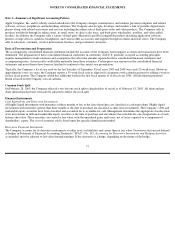Apple 2006 Annual Report Download - page 79
Download and view the complete annual report
Please find page 79 of the 2006 Apple annual report below. You can navigate through the pages in the report by either clicking on the pages listed below, or by using the keyword search tool below to find specific information within the annual report.
NOTES TO CONSOLIDATED FINANCIAL STATEMENTS (Continued)
Note 1—Summary of Significant Accounting Policies (Continued)
changes in fair value will either be offset against the change in fair value of the hedged assets, liabilities, or firm commitments through
earnings, or recognized in other comprehensive income until the hedged item is recognized in earnings.
For derivative instruments that hedge the exposure to variability in expected future cash flows that are designated as cash flow hedges, the
effective portion of the gain or loss on the derivative instrument is reported as a component of accumulated other comprehensive income in
shareholders’ equity and reclassified into earnings in the same period or periods during which the hedged transaction affects earnings. The
ineffective portion of the gain or loss on the derivative instrument is recognized in current earnings. To receive hedge accounting treatment,
cash flow hedges must be highly effective in offsetting changes to expected future cash flows on hedged transactions. For derivative
instruments that hedge the exposure to changes in the fair value of an asset or a liability and that are designated as fair value hedges, the net
gain or loss on the derivative instrument as well as the offsetting gain or loss on the hedged item attributable to the hedged risk are recognized
in earnings in the current period. The net gain or loss on the effective portion of a derivative instrument that is designated as an economic hedge
of the foreign currency translation exposure of the net investment in a foreign operation is reported in the same manner as a foreign currency
translation adjustment. For forward contracts designated as net investment hedges, the Company excludes changes in fair value relating to
changes in the forward carry component from its definition of effectiveness. Accordingly, any gains or losses related to this component are
recognized in current earnings.
Inventories
Inventories are stated at the lower of cost, computed using the first-in, first-out method, or market. If the cost of the inventories exceeds their
market value, provisions are made currently for the difference between the cost and the market value. The Company’s inventories consist
primarily of finished goods for all periods presented.
Property, Plant, and Equipment
Property, plant, and equipment are stated at cost. Depreciation is computed by use of the straight-line method over the estimated useful lives of
the assets, which for buildings is the lesser of 30 years or the remaining life of the underlying building, up to 5 years for equipment, and the
shorter of lease terms or 10 years for leasehold improvements. The Company capitalizes eligible costs to acquire or develop internal-use
software that are incurred subsequent to the preliminary project stage. Capitalized costs related to internal-use software are amortized using the
straight-line method over the estimated useful lives of the assets, which range from 3 to 5 years. Depreciation and amortization expense on
property and equipment was $180 million, $141 million, and $126 million during 2006, 2005, and 2004, respectively.
Asset Retirement Obligations
The Company records obligations associated with the retirement of tangible long-lived assets and the associated asset retirement costs in
accordance with SFAS No. 143, Accounting for Asset Retirement Obligations . The Company reviews legal obligations associated with the
retirement of long-lived assets that result from the acquisition, construction, development and/or normal use of the assets. If it is determined
that a legal obligation exists, the fair value of the liability for an asset retirement obligation is recognized in the period in which it is incurred if
a reasonable estimate of fair value can be made. The fair value of the liability is added to the carrying amount of the associated asset and this
additional carrying amount is depreciated over the life of the asset. The difference between the gross expected future cash flow and its
78
























